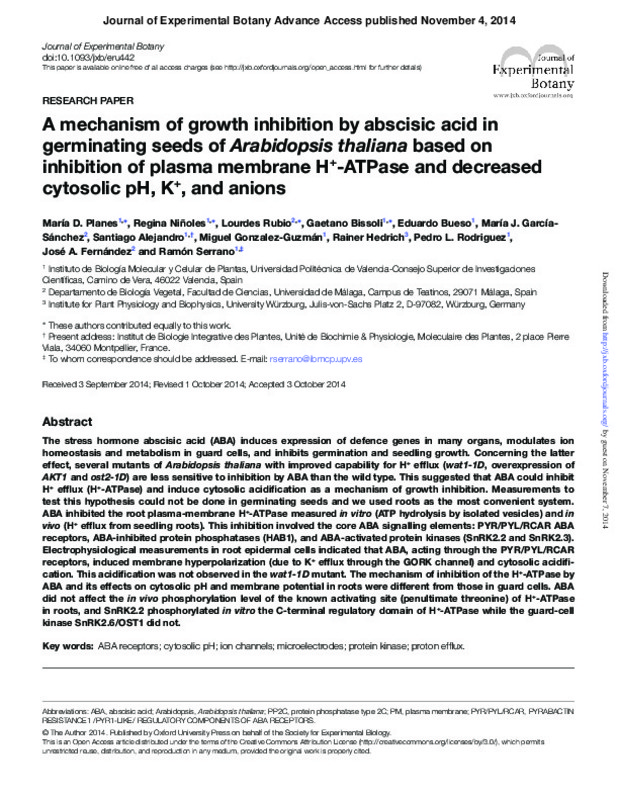Planes Ferrer, MD.; Niñoles Rodenes, R.; Rubio, L.; Bissoli, G.; Bueso Ródenas, E.; Garcia-Sanchez, MJ.; Alejandro Martínez, S.... (2015). A mechanism of growth inhibition by abscisic acid in germinating seeds of Arabidopsis thaliana based on inhibition of plasma membrane H+-ATPase and decreased cytosolic pH, K+, and anions. Journal of Experimental Botany. 66(3):813-825. https://doi.org/10.1093/jxb/eru442
Por favor, use este identificador para citar o enlazar este ítem: http://hdl.handle.net/10251/65080
|
Título:
|
A mechanism of growth inhibition by abscisic acid in germinating seeds of Arabidopsis thaliana based on inhibition of plasma membrane H+-ATPase and decreased cytosolic pH, K+, and anions
|
|
Autor:
|

 Planes Ferrer, Mª Dolores
Planes Ferrer, Mª Dolores

 Niñoles Rodenes, Regina
Rubio, Lourdes
Niñoles Rodenes, Regina
Rubio, Lourdes

 Bissoli, Gaetano
Bissoli, Gaetano

 Bueso Ródenas, Eduardo
Garcia-Sanchez, Maria J.
Alejandro Martínez, Santiago
González Guzmán, Miguel
Hedrich, Rainer
Bueso Ródenas, Eduardo
Garcia-Sanchez, Maria J.
Alejandro Martínez, Santiago
González Guzmán, Miguel
Hedrich, Rainer

 Rodríguez Egea, Pedro Luís
Fernandez, Jose A
Rodríguez Egea, Pedro Luís
Fernandez, Jose A
 Serrano Salom, Ramón
Serrano Salom, Ramón
|
|
Entidad UPV:
|
Universitat Politècnica de València. Instituto Universitario Mixto de Biología Molecular y Celular de Plantas - Institut Universitari Mixt de Biologia Molecular i Cel·lular de Plantes
Universitat Politècnica de València. Departamento de Biotecnología - Departament de Biotecnologia
|
|
Fecha difusión:
|
|
|
Resumen:
|
[EN] The stress hormone abscisic acid (ABA) induces expression of defence genes in many organs, modulates ion
homeostasis and metabolism in guard cells, and inhibits germination and seedling growth. Concerning the ...[+]
[EN] The stress hormone abscisic acid (ABA) induces expression of defence genes in many organs, modulates ion
homeostasis and metabolism in guard cells, and inhibits germination and seedling growth. Concerning the latter
effect, several mutants of Arabidopsis thaliana with improved capability for H+
efflux (wat1-1D, overexpression of
AKT1 and ost2-1D) are less sensitive to inhibition by ABA than the wild type. This suggested that ABA could inhibit
H+
efflux (H+
-ATPase) and induce cytosolic acidification as a mechanism of growth inhibition. Measurements to
test this hypothesis could not be done in germinating seeds and we used roots as the most convenient system.
ABA inhibited the root plasma-membrane H+
-ATPase measured in vitro (ATP hydrolysis by isolated vesicles) and in
vivo (H+
efflux from seedling roots). This inhibition involved the core ABA signalling elements: PYR/PYL/RCAR ABA
receptors, ABA-inhibited protein phosphatases (HAB1), and ABA-activated protein kinases (SnRK2.2 and SnRK2.3).
Electrophysiological measurements in root epidermal cells indicated that ABA, acting through the PYR/PYL/RCAR
receptors, induced membrane hyperpolarization (due to K+
efflux through the GORK channel) and cytosolic acidification.
This acidification was not observed in the wat1-1D mutant. The mechanism of inhibition of the H+
-ATPase by
ABA and its effects on cytosolic pH and membrane potential in roots were different from those in guard cells. ABA
did not affect the in vivo phosphorylation level of the known activating site (penultimate threonine) of H+
-ATPase
in roots, and SnRK2.2 phosphorylated in vitro the C-terminal regulatory domain of H+
-ATPase while the guard-cell
kinase SnRK2.6/OST1 did not.
[-]
|
|
Palabras clave:
|
ABA receptors
,
cytosolic pH
,
Ion channels
,
Microelectrodes
,
Protein kinase
,
Proton efflux
|
|
Derechos de uso:
|
Reserva de todos los derechos
|
|
Fuente:
|
Journal of Experimental Botany. (issn:
0022-0957
) (eissn:
1460-2431
)
|
|
DOI:
|
10.1093/jxb/eru442
|
|
Editorial:
|
Oxford University Press (OUP)
|
|
Versión del editor:
|
https://dx.doi.org/10.1093/jxb/eru442
|
|
Código del Proyecto:
|
info:eu-repo/grantAgreement/MICINN//BFU2011-22526/ES/NUEVOS MECANISMOS DE TRANSMISION DE SEÑALES DURANTE EL METABOLISMO DE GLUCOSA Y LA ACIDIFICACION INTRACELULAR: AMPLIANDO LAS FUNCIONES DE LA PROTEINA FOSFATASA 1 Y LA PROTEINA/
info:eu-repo/grantAgreement/MICINN//BIO2011-23446/ES/SEÑALIZACION DE ABA MEDIADA POR LOS RECEPTORES PYR%2FPYL Y SU CONEXION CON LOS MECANISMOS DE RESISTENCIA A SEQUIA/
info:eu-repo/grantAgreement/GVA//PROMETEO%2F2010%2F038/
|
|
Agradecimientos:
|
This work was funded by grants BFU2011-22526 (to RS) and BIO2011-23446 (to PLR) of the Spanish 'Ministerio de Economia y Competitividad', Madrid, Spain, and grant PROMETEO/2010/038 (to RS) of the 'Generalitat Valenciana', ...[+]
This work was funded by grants BFU2011-22526 (to RS) and BIO2011-23446 (to PLR) of the Spanish 'Ministerio de Economia y Competitividad', Madrid, Spain, and grant PROMETEO/2010/038 (to RS) of the 'Generalitat Valenciana', Valencia, Spain. MGG was funded by a JAE-DOC contract of the Spanish 'Consejo Superior de Investigaciones Cientificas', Madrid, Spain. We thank Dr Toshinori Kinoshita (Nagoya University, Nagoya, Japan) for the rabbit antibody against the last 9 aa of AHA2 H<SUP>+</SUP>-ATPase with the penultimate Thr947 phosphorylated. We also thank the Proteomics Facility of the 'Centro Nacional de Biotecnologia', Madrid, Spain, for the attempts to identify the phosphorylation site of the H<SUP>+</SUP>-ATPase.
[-]
|
|
Tipo:
|
Artículo
|









